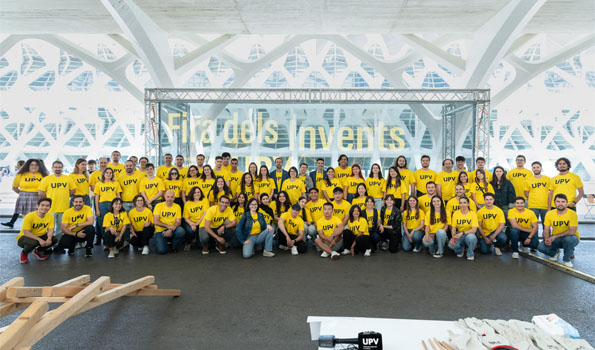UPV Inventions Fair 2025
The UPV takes its most cutting-edge research and dissemination projects to the streets to bring science closer to society
[ 14/05/2025 ]
Drug detection, such as burundanga, through nanomaterials, applications to locate jellyfish in the sea using artificial intelligence, a robot that detects when the fruit is ripe enough to be harvested, and the development of the first Valencian satellite made by UPV students. Altogether, more than 40 were showcased at the UPV Inventions Fair with the aim of bringing science closer to society.
The public response was immediate, and a large number of schoolchildren, students, families and even tourists filled the City of Arts and Sciences from early in the morning to learn about some research projects currently underway at the Universitat Politècnica de València.
For the Vice-Rector for Communication, José Francisco Monserrat, 'It is very stimulating to see so many people, young and older, families, who come to find out about our daily life at the university. We aim to bring science closer to our society and let people know about all the work we do at the UPV.
Research for health
The Universitat Politècnica de València works in a wide range of research fields, from research with medical applications such as the development of biomaterials to understand the mechanism of certain diseases or map the heart without touching it through multi-cameras to the development of a prototype to fragment kidney stones or the analysis of cranial deformities in 3D.
This is where the Dana reached
Among the workshops and stands that attracted the most attention from the public were those dedicated to the preservation of the collection of historic radios damaged by the Dana and the restoration of photographs damaged by mud, as well as the stand 'This is where the Dana reached', which displayed a street-by-street map of the flooding in the municipalities of l'Horta Sud, created using GPS sensors and cartographic databases.
Awakening scientific vocations
In addition, to bring science closer to children, the fair included a dozen workshops where they could discover all the physics behind our mobile phones, carry out fun chemical experiments, build a bridge in a matter of minutes and cross it, and create figures with a 3D pen. Furthermore, many of the attendees could climb into a prototype vehicle capable of travelling more than 1,000 km on one litre of fuel, as well as take a photo in the fun photocall, which, under the slogan ‘Science is cool’, attracted the attention of not only children but also people of all ages.
The UPV Invention Fair is part of the annual scientific dissemination programme of the Universitat Politècnica de València. It has been organised in collaboration with the City of Arts and Sciences and with the support of the Spanish Foundation for Science and Technology (FECYT) of the Ministry of Science, Innovation and Universities.
Outstanding news
 The Diamond Army
The Diamond Army
Two students came up with the UPV initiative that has engaged more than 1,600 volunteers and shattered the false myth of the 'crystal generation'
 ARWU 2024
ARWU 2024
The Shanghai ranking reaffirms the UPV as the best polytechnic in Spain for yet another year
 Distinction of the Generalitat for Scientific Merit
Distinction of the Generalitat for Scientific Merit
Guanter has been distinguished in recognition of his research excellence in the development of satellite methods for environmental applications
 The new statutes come into force
The new statutes come into force
The Universitat Politècnica de València is the first university in Spain with statutes adapted to the new LOSU
 NanoNIR project against breast cancer
NanoNIR project against breast cancer
UPV Researcher Carla Arnau del Valle receives an EU Marie Curie grant to develop biosensors for the early detection of this cancer
 Large artificial intelligence language models, increasingly unreliable
Large artificial intelligence language models, increasingly unreliable
According to a study by the Universitat Politècnica de València, ValgrAI and the University of Cambridge, published in the journal Nature





